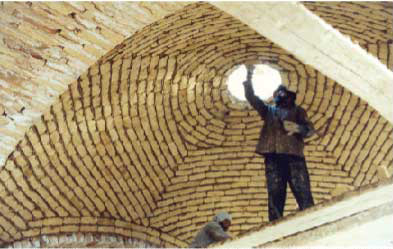Dachverband Lehm e.V. announces the LEHM 2004 conference program.
Friday, 29.10.2004 9 a.m.- 6 p.m.
Opening address:
Dr. Horst Schroeder, Chairman of the Dachverband Lehm e.V. (DVL)
Prof. Dr. Michael Petzet, President of ICOMOS International
Earthen building: A thousand years of building culture
• Christian Manhard, UNESCO, Cultural Division: The UNESCO and the conversation of historic earthen architecture in Iran and Afghanistan
• Azimeh Riahi Dekhordi, architect, Iranian Cultural Heritage Organisation (ICHO), Tehran, Iran: Traditional earthen architecture in Abianeh, Iran
• Hamid Reza Jayhani & Seyed Mohammad Ali Emrani, assistant director & technical director, ICHO, Tehran, Iran: From the spirit of adobe to the inner essence of earthern structures in the Persian architecture
• Natalia Turekulova & Timur Turekulov, architects, Kumbez Ltd, Almaty, Kazakhstan: 3000 year old cities along the Syr-Daria river, Republic of Kazakhstan
• Louise Cooke, archaeologist, Institute of Archaeology, University College, London, UK: Earthen building materials and techniques at Merv, Turkmenistan
• Dr. Ju Liang & Prof. Dr. Katsutada Onitsuka & Peihang Chen & Yuya Oryouji, Dept. of Civil Engineering, Saga University, Japan: Geotechnical investigations on earthen historical remains
• Roderich Seefried, DVL, Lebensraum, Wald-Rothenlachen, D: The Heuneburg an der Donau – the earliest use of adobe bricks north of the Alps
• Ronald Rael, architect, Clemson University, USA: A counter history of modern architecture
• Hossein S. M. Ayatollahi, School of Architecture, Yazd University, Iran: Testing “grounded theories” for measuring the qualitative characteristics of earthen architecture
• Dr. René Herdick, architect, Munich, D: Endangered traditional earthen architecture in Ladakh, India
• Anke Richter, DVL, building engineer, Weimar, D: Conservation of traditional earthen architecture in Southern Morocco
• Anna Paola Conti, architect, Macerata, I: Villa Ficana – an urban quarter in the town of Macerata, Italy
• Richard Rath, student, TU Berlin, D: Earthen building in the former Soviet occupied territories and the former DDR 1945 – 1989
Questions and discussion
Banquet
As part of the LEHM 2004 the Dachverband Lehm e.V. has organised a reception with banquet on the 29th October at the Moritzbastei, Leipzig University’s historic cultural centre in the city centre.
Saturday, 30.10.2004 9:30 a.m. – 6 p.m.
New earthen building technology in conservation practice and the new projects forum
• Alejandro Alva Balderrama & Cristina Albertini, ICCROM, Architecture and Archeaological Sites unit director & research assistant, Rome, I: ICCROM’s activities on the study and the conservation of earthen architecture
• Dr. Abdulhakiem Bazara, building engineer, Berlin, D and Aden, Yemen: The conservation of earthen buildings in Wadi Hadramaut, Yemen
• Anett Richter, restorer, Berlin, D: Securing earthen building elements in the pyramid complexes in Egypt
• Roberto Orazi & Francesca Colosi, architect & archaeologist, CNR-ITABC, Rome, I: New technologies for the conservation of the Archaeological Park of Chan Chan (Peru)
• Marina Reutova & Prof. Dr. Timur S. Shirinov, head of dept. & director, Institute of Archaeology, Samarkand, Uzbekistan: Adobe building materials in Central Asia – the conservation of archaeological earthen monuments
• Michael Thˆnnes, interior designer, Druwid, Waimes, Belgium: Renovation of historic half-timbered constructions in Belgium using earthen building materials
• Frank Hawemann, DVL, building engineer, Lehmprojekt, Dresden, D: Refurbishing system-built prefab housing using earthen materials
• Dr. Horst Schroeder, DVL, building engineer, Bauhaus-Universitat Weimar, D: New rammed-earth projects in Thuringia, Germany
• Dr. Christof Ziegert, DVL, building engineer, zrs Architekten & Ingenieure, Berlin, D: The conservation and building of monolithic earthen construction
• Dr. Kevan Heathcote & Gregory Moor, Faculty of Design, Architecture and Building, University of Technology, Sydney, Australia: The UTS durability test for earth wall construction. The seismic vulnerability of earthen building constructions
• Dr. Dinu Bumbaru, general secretary, ICOMOS International, Montreal, Canada: The earthquake catastrophe in Bam, Iran, December 2003 – future strategies for a destroyed city made of earth
• Dr. Abdolrasool Vatandoust, Director, Research Center for Conservation of Cultural Relics (RCCCR), Tehran, Iran: The citadel in Bam – an analysis of the earthquake damage from December 2003 and strategies for its reconstruction
• Dr. Jochen Schwarz, Christian Kaufmann, Tobias Langhammer, Bachrom A. Tulaganov, building engineers, Earthquake Institute, Bauhaus-Universitat Weimar, D & Dr. Shamil A. Chakimov, building engineer, UZLITTI Tashkent, Uzbekistan: The seismic vulnerability of traditional building constructions and an assessment of improvement strategies – case studies after the earthquakes in 2000 and 2001 in Kamashi, Republic of Uzbekistan
• Prof. Dr. Kabul S. Abdurashidov, Prof. Dr. Abdukabil Tulaganov, DVL, K. Pirmanov; TASI School of Architecture and Construction, Tashkent, Uzbekistan: An evaluation of the earthquake resistance of traditional earthen building constructions in Central Asia
Questions and discussion
Sunday, 31.10.2004 10 a.m.- 6 p.m.
Field trip I – Modern Building with Earth
Selected examples in and around Dresden
or
Field trip II – Historic Earthen Building in Saxony
Selected examples in and around Leipzig


